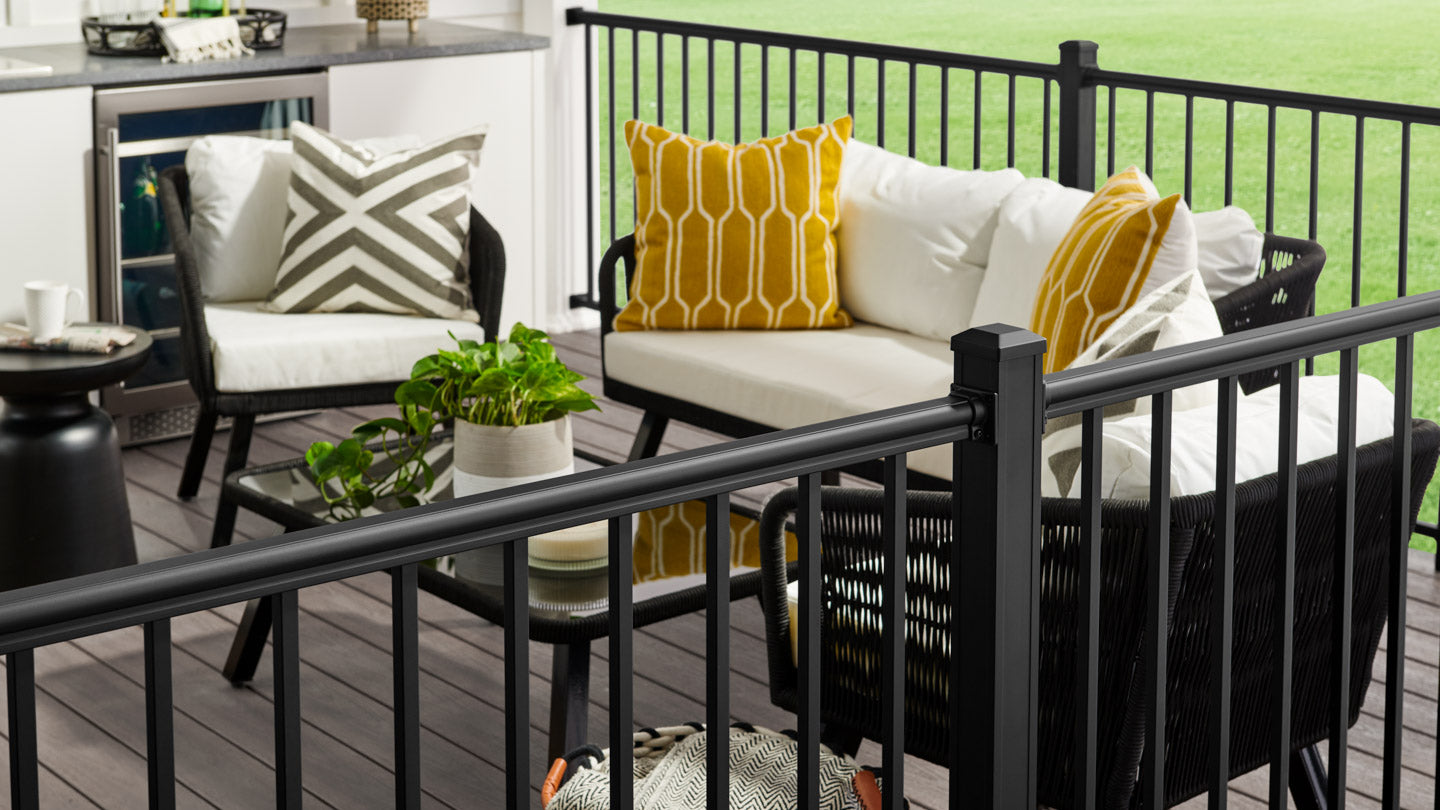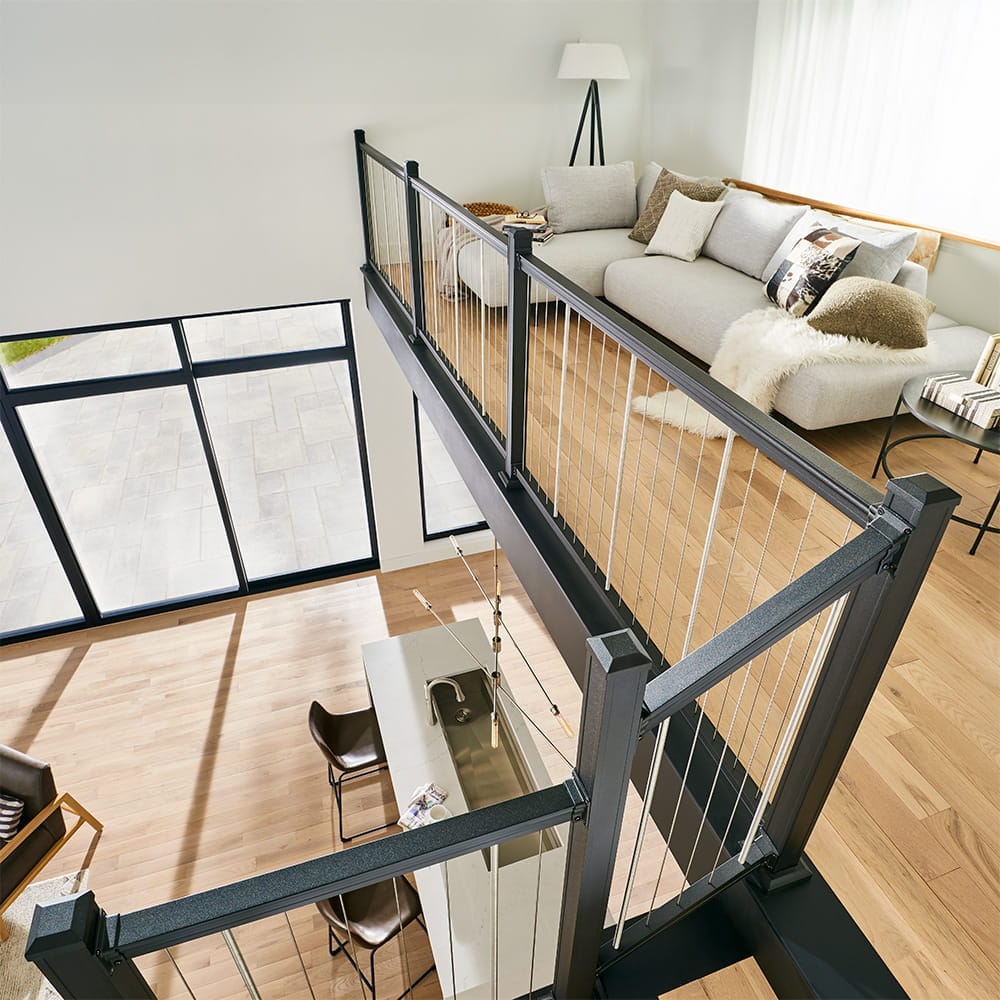What is the best material for deck railing?


What is the best deck railing material?
We believe the best deck railing material is powder coated aluminum due to its strength, durability, and long product life.
Deck railing selection can be daunting. There are several other options available such as aluminum, composite & vinyl, and traditional wood railing. We'll compare the industry's most popular options, and what kind of decking pairs well with each.
Powder Coated Aluminum Railing

Powder coated aluminum railing is amongst the most popular railings today due to its thin profile, high quality finishes and variety of infill options. Today's aluminum isn't your grandfather's old wrought iron railing. Aluminum railing is powder coated with a durable, fade resistant finish. Aluminum is also anti corrosive, so you won't have to worry about the substrate rusting over time. We highly recommend choosing a railing with an AAMA 2604 powder coating finish or if your railing is exposed to salt water, AAMA 2605 finish.
Aluminum railing comes in a variety of infill options such as stainless-steel cable, glass, and aluminum support balusters. Stainless steel cable, both vertical cable and horizontal cable railing are the most sought desirable options for their high visibility and contemporary styling. Glass panels offer excellent visibility and have the added benefit of blocking the wind. Aluminum support balusters are the most affordable option and have a smaller baluster profile than cheaper railing alternatives.
When maintaining aluminum railings, never use abrasive cleaners. These products could damage the surface of your rails. Instead, use warm water mixed with mild soap.
Due to the limited maintenance required with aluminum railing, we suggest pairing it with low maintenance decking. PVC or a high-quality composite decking will ensure that you have low maintenance and long-lasting outdoor living space for years to come.
Composite & Vinyl Railing

Composite and vinyl railing has seen some of its market share start to decrease with the rise of aluminum railing, but it still is widely popular with homeowners because of its ease of installation and low maintenance. Composite compound comprises of a mixture of recycled plastic, wood flour and PVC. Vinyl railing features an extruded vinyl shell that is supported by an aluminum insert. Composite and vinyl railings are usually bulkier, using larger extruded balusters and favor a post sleeve that is installed over a 4x4.
The more expensive vinyl railing varieties are long-lasting and tough and have well engineered metal inserts for stiffness and sturdiness. Vinyl doesn't stain or gather mold as easily as composite materials in most cases, and its smooth surface makes it easier to clean. But there are some downsides. Because the rails are hollow, they can sometime creek and be pressed in under pressure.
Infill options are more limited with composite system. These systems are usually offered in a vertical round or square baluster. However, cable railing is an option if used with an external cable railing fitting. Simply drill through your line posts and screw the external fitting into the 4x4 posts.
Like aluminum railing, we recommend pairing composite and vinyl railing with low maintenance decking such as budget composite decking.
Wood Railing

Wooden deck railing is a classic rustic look that adds character to outdoor spaces. But it requires some maintenance to maintain its beauty. Most people don't realize how much work goes into keeping their wood decks in good shape. A professionally installed wood deck can last decades, but even well maintained wood decks can require routine care. If you're planning to build a deck, make sure you know what you'll need to do to keep it beautiful.
Pressure Treated Railing
Pressure treated lumber is the most common form of wood railing. Pressure-treated lumber has been around since the early 1900s, when it was introduced to protect timber against insects and decay. Today, many types of wood are treated with copper azoles, including pine, fir, cedar, hemlock, redwood, cypress, Douglas fir, and others. These treatments are designed to make the wood resistant to rotting and termites. They are also meant to stop sap from penetrating the wood.
The process of treating lumber involves immersing the wood in a tank filled with preservative solution. This causes the chemicals to penetrate deeper into the wood than just coating the surface. When the wood dries out, it becomes harder and stronger due to the chemical reaction.
Pressure treating lumber is one way to keep it protected against insects and rot. But while it does protect the wood from bugs and decay, it doesn't stop moisture from getting inside. If you live where there is heavy rain, water can seep into the wood causing it to expand, crack and warp over time.
To avoid this problem, you'll want to seal your deck regularly. A good sealant will make sure that no moisture gets inside, preventing the wood from expanding and cracking. In addition, sealing helps preserve the natural beauty of your deck. You won't have to worry about fading colors because the sealant protects the wood from exposure to sunlight.
Cedar Railing
Cedar is a naturally rot resistant wood species which has made it a popular choice for a DIY wood railing. Pressure treated lumber, often Southern Yellow Pine, is lumber that has been impregnated with a chemical to make it less susceptible to rot and bug infestation. Lumber requires the most maintenance of all the railing options listed. Typically, you will need to power wash and stain the railing every one to three years.


